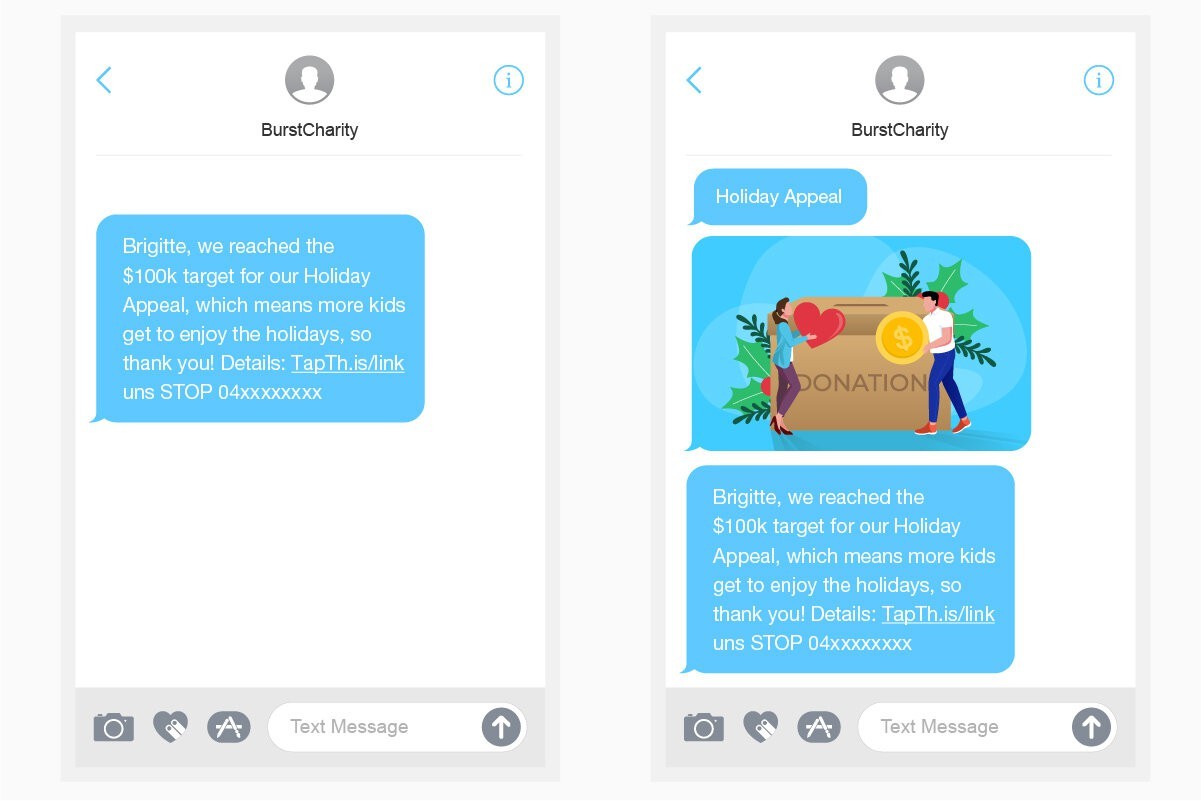1.1 What is an SMS?
SMS stands for Short Message Service, usually known as a text message. They’re ubiquitous—meaning any mobile phone in the world can send and receive SMS right out of the box without a data connection.
A single text message has a 160 character limit, but you can send up to 612 characters in the form of four concatenated messages. Learn how to measure your SMS character count and how concatenation works.
1.2 What is an MMS?
MMS stands for Multimedia Message Service, and they’re less common than SMS for business use. In its simplest definition, MMS is a more visual version of an SMS.

MMS does everything an SMS can with exception to having 2-way capabilities and keywords. It has an extended set of features, which includes a longer character count, subject line, and image and GIF capabilities.
SMS vs MMS
| SMS | MMS | |
| Subject Title | Not Available | Up to 20 characters |
| Message Copy | Up to 612 Characters _1-3x Concatenation after 160_ | Up to 1,000 Characters _No concatenation_ |
| Custom Sender ID | Available | Available |
| 2 Way SMS | Available | Not Available |
| Keywords | Available | Not Available |
| Unicode Characters | Available | Available |
| Website Links | Available | Available |
| Unique Link Tracking | Available | Not Available |
| Multimedia Files | Not Available | .jpg and .gif |
| Pricing | Based on # of messages | Based on overall file size |
MMS is about 4-5x more expensive than an SMS, and each campaign includes setup fees.
MMS Resources
- The mystery behind MMS vs SMS marketing
- How to design the perfect MMS
- MMS Templates: Animated GIFs edition
If you’re interested in sending an MMS campaign, get in touch with us.
1.3 Virtual Numbers
If you want to create a consistent and memorable customer experience, then you should use a dedicated virtual number or shortcode when sending SMS marketing campaigns.
Lease these numbers on a month-to-month basis and cancel them at any time.
Dedicated Virtual Numbers
Dedicated Virtual Numbers, which are also known as long codes or response numbers, look like regular numbers and can receive SMS.
There are three types: standard, gold, and vanity.
Gold numbers are easy to recognise and remember, while vanity numbers spell out a word using your mobile phone’s keypad.
- Standard number: +61 467 528 788
- Gold number: +61 459 333 444
- Vanity number: +61 467 528 778 (614675BURST)
When you lease a dedicated virtual number, you also have the option to send your SMS marketing campaigns with a Custom Sender ID.
Instead of coming from a number, your campaign comes from a name. You can’t receive SMS replies directly though, making it inconvenient for opt-outs.
Recipients need to text your number directly instead of replying to your message. Custom Sender IDs are better for one way SMS campaigns.
Shared Virtual Numbers
If you choose not to lease a dedicated virtual number, our online SMS service provides you with a free shared virtual number to use.
Imagine yourself receiving three text messages from the same business but each from a different number. For SMS marketing campaigns, this might work, but for security messages, it’s better to have it come from a dedicated number.
Shortcodes
Shortcodes are similar to dedicated virtual numbers, but they’re much more expensive. They range from 4 to 6 digits (e.g. 134568). Their length depends on the country’s delivery policies and general availability.
Some countries, like New Zealand, require you to send messages via shortcode only. Large enterprises and organisations use them for promotions, voting, and information services.
1.4 Spam Compliance
We all know as consumers ourselves, spam is a big no-no.
Spam laws aren’t meant to handcuff your SMS marketing campaigns. Abiding by them helps you create better campaigns that build trust with your customers.
To be spam compliant, there are a few important rules to follow:
- Permissions: The recipient must be aware that they opted-in to receive commercial messages from your company
- Identify yourself: By law, you must always identify yourself by company name either in the Sender ID or within the body copy of your text message.
- Opt-out option: Give them the option to unsubscribe. As a responsible sender, you must provide an opt-out. This must be displayed within the SMS, usually on the very bottom of any message. Most SMS platforms automatically generate this opt-out for you inside your message composer.
There are organisations that are exempt from the SPAM law in specific countries. For example, in Australia, these exemptions include:
- Government bodies
- Registered charities
- Registered political parties
- Educational institutions
- Purely factual messages
Spam compliance is all about doing the right thing for your audience. If you’d like to learn more about building your SMS list the right way, check out our anti-spam policy.